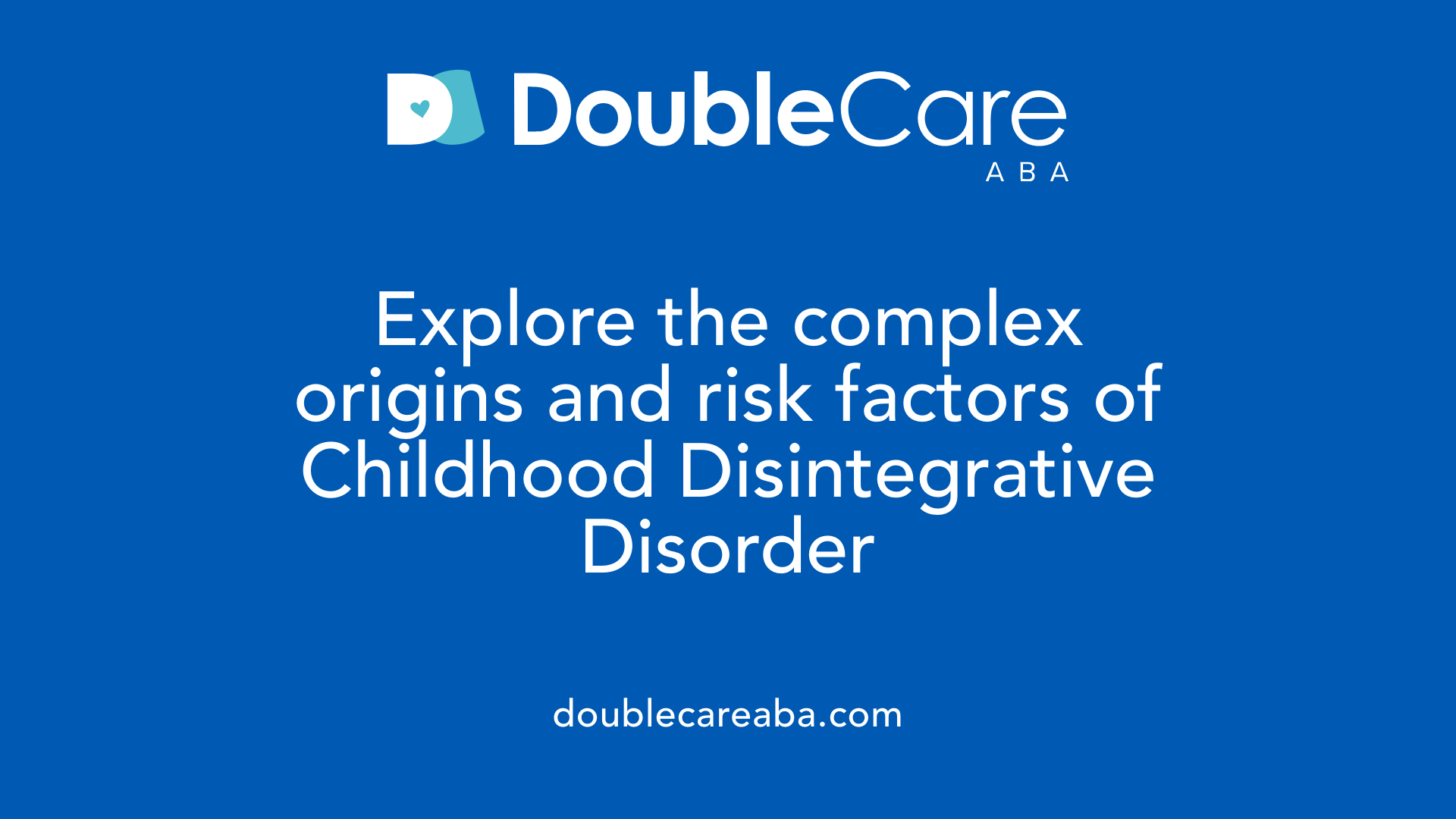Childhood Disintegrative Disorder
Understanding the Rare Neurodevelopmental Condition

A Closer Look at Childhood Disintegrative Disorder
Childhood Disintegrative Disorder (CDD), also known as Heller syndrome, is a rare but severe developmental condition characterized by late-onset regression in a child's functional abilities. Despite its rarity, understanding CDD is crucial for early diagnosis, intervention, and support for affected families. This article explores the clinical features, causes, diagnosis, treatment options, and ongoing research surrounding this complex disorder.
Clinical Features and Symptoms of Childhood Disintegrative Disorder
What are the clinical features and symptoms of Childhood Disintegrative Disorder?
Children with Childhood Disintegrative Disorder (CDD) usually grow and develop normally for at least the first two to three years of life. During this period, they typically reach important developmental milestones in language, social skills, motor abilities, and self-care tasks. However, this normal development is followed by a sudden or gradual regression in multiple functional areas.
The onset of symptoms generally occurs between ages 3 and 10, often around ages 3 to 4. During this phase, children begin to lose previously acquired skills. They may stop speaking or their language skills might deteriorate, speaking in shorter phrases or becoming non-verbal. Social withdrawal is common, with children showing decreased interest in play and interaction, and sometimes withdrawing from family members and peers.
Motor skills can also decline, leading to difficulties with coordination, walking, or fine motor tasks. Additionally, children may lose bowel and bladder control, which they had previously mastered. Other signs include repetitive behaviors such as rocking or hand-flapping, emotional disturbances like fearfulness or irritability, sleep problems, and severe behavioral changes.
This pattern of sudden or gradual skill loss occurs over several months and, in most cases, children do not recover these skills. The regression tends to be more extensive compared to classic autism, often affecting multiple domains. Importantly, children are often aware of their loss, which can increase anxiety or distress.
The cumulative impact of these symptoms results in significant impairments in daily living and long-term functioning. Most children with CDD require lifelong support, with many experiencing severe intellectual disabilities and ongoing developmental challenges. The pattern of delayed onset followed by rapid regression differentiates CDD from other developmental disorders and makes early diagnosis and intervention crucial.
Understanding the Causes and Risk Factors

What are the causes and risk factors associated with Childhood Disintegrative Disorder?
The precise origins of Childhood Disintegrative Disorder (CDD) are still not fully understood. Most researchers agree that it likely results from a complex interplay of genetic, neurobiological, and environmental influences.
From a neurobiological perspective, abnormal brain development and functioning are thought to play a significant role. Brain imaging and EEG studies often reveal irregularities, especially in regions like the temporal lobes and prefrontal cortex, which are crucial for language, social skills, and executive functions. These disturbances might interfere with normal synaptic transmission, resulting in the sudden or gradual loss of skills that characterize CDD.
Genetic susceptibility also appears to be important. Children with a family history of autism spectrum disorder or related neurodevelopmental conditions may have a higher likelihood of developing CDD. While specific genes have not been conclusively linked to the disorder, family and twin studies suggest a hereditary component.
Environmental factors during prenatal and early childhood stages may increase the risk. These include viral infections during pregnancy, birth trauma, exposure to toxins such as heavy metals or certain medications, prematurity, and other teratogenic effects. Some cases are associated with medical conditions like tuberous sclerosis, lipid storage diseases, and autoimmune disorders. Although these conditions are not direct causes, their presence correlates with higher incidences of CDD.
Other factors that may contribute include early disruptions in brain growth, birth complications, or prenatal exposure to infections and toxins. However, because CDD is rare, establishing definitive causal links remains challenging.
| Factor Category | Examples and Details | Potential Impact |
|---|---|---|
| Genetic Factors | Family history of ASD, genetic susceptibility | Increased risk due to inherited predispositions |
| Neurobiological Abnormalities | Brain structural differences, EEG abnormalities | Disruptions in neural communication affecting development |
| Prenatal Environmental Exposures | Maternal infections, toxins, teratogens | Possible interference with normal brain development |
| Birth and Early Childhood Events | Asphyxia, premature birth, birth trauma | Can contribute to neural and developmental issues |
| Associated Conditions | Tuberous sclerosis, lipid storage diseases, autoimmune conditions | May indicate underlying neurodevelopmental vulnerabilities |
Understanding these factors helps in recognizing potential early signs and underscores the importance of thorough evaluations in children showing developmental regressions.
Diagnosing CDD: Criteria and Approaches

How is Childhood Disintegrative Disorder diagnosed?
Diagnosing Childhood Disintegrative Disorder (CDD) involves a thorough evaluation by trained healthcare professionals such as pediatric neurologists or developmental pediatricians. The process begins with collecting a detailed developmental history, focusing on establishing a baseline of typical early development and identifying the onset of regression.
Children with CDD typically develop normally until at least age 2, sometimes up to age 4, after which they begin to lose skills. To meet diagnostic criteria, these children must demonstrate significant regression in multiple areas such as language, social interaction, play, motor skills, and bladder or bowel control.
The key aspect is that the regression occurs after at least two years of normal development and generally before age 10. The regressions can be sudden or gradual and are often noticeable through loss of previously acquired abilities.
Diagnostic assessment includes neurological examinations, speech and language tests, behavioral evaluations, and sometimes genetic or metabolic testing to rule out other causes. Behavioral inventories and observational assessments help identify autistic-like behaviors, restricted interests, and repetitive behaviors.
Ultimately, diagnosis hinges on recognizing a clear pattern: normal early development, followed by a substantial decline in multiple developmental domains, and excluding other potential causes like brain injury, infections, or genetic syndromes. Proper diagnosis ensures appropriate intervention planning, even though no cure exists for CDD.
Therapeutic Strategies and Management
 Children diagnosed with Childhood Disintegrative Disorder (CDD) require a comprehensive, multidisciplinary approach to management. Early intervention is crucial to help maximize developmental potential and improve quality of life.
Children diagnosed with Childhood Disintegrative Disorder (CDD) require a comprehensive, multidisciplinary approach to management. Early intervention is crucial to help maximize developmental potential and improve quality of life.
A core component of treatment involves behavioral therapies, especially applied behavior analysis (ABA), which helps reinforce positive behaviors and improve social, communication, and adaptive skills. Complementary therapies such as speech, occupational, and physical therapies support language development, motor skills, and daily living activities.
Since CDD shares similarities with autism spectrum disorder, medication management is often used to address co-occurring behavioral and medical symptoms. Antipsychotics like risperidone can help manage aggression and self-injurious behaviors, while anticonvulsants may control seizures common in many cases. Medications do not directly treat the core deficits but are instrumental in symptom management.
Supporting families and training caregivers are vital for ongoing management. Educating families about the disorder, behavioral strategies, and medication use empowers them to provide consistent support and create a conducive environment for the child's development.
Despite the absence of a cure, continuous therapy and support can help individuals maintain as much independence as possible and adapt to ongoing challenges. Lifelong support may involve assistance with daily activities, social integration, and managing health complications.
| Treatment Component | Description | Additional Notes |
|---|---|---|
| Early intervention | Initiating therapies as soon as possible after diagnosis | Improves developmental outcomes |
| Behavioral therapy | Applied behavior analysis (ABA) and others | Enhances communication and social skills |
| Speech & language therapy | Focuses on improving communication | Can include augmentative communication methods |
| Occupational & physical therapy | Supports motor skills and daily functioning | Tailored to individual needs |
| Medication | Used for behavioral, seizure, or psychiatric symptoms | No medication targets core CDD symptoms |
| Family support | Training, counseling, and education | Ensures effective care at home |
| Lifelong management | Continuous therapy and support | Adaptive strategies for ongoing needs |
While treatments can improve functioning and reduce problematic behaviors, it is important to recognize that many children with CDD may need lifelong support to navigate daily life and health challenges.
Prognosis, Outcomes, and Future Outlook

What is the prognosis and long-term outlook for individuals with Childhood Disintegrative Disorder?
Children diagnosed with CDD typically face a challenging long-term course. The prognosis is generally considered poor, as most children experience extensive, often permanent loss of previously acquired skills such as language, social skills, and self-care activities. These regressions usually occur before the age of 10, often between ages 3 and 4, and can be sudden or gradual.
Despite the severe impairments, most individuals with CDD tend to have a normal lifespan, but their quality of life often involves ongoing substantial support needs. Many require lifelong assistance with daily activities, and some may eventually reside in specialized care facilities.
Medical comorbidities, especially epilepsy, are common in children with CDD, occurring in a significant proportion of cases. These additional conditions can further complicate the health and management of affected individuals.
Response to treatment varies considerably. Early, intensive behavioral and developmental therapies, along with medications to control behavioral and seizure-related symptoms, can lead to some improvements in social, language, and motor skills. However, complete recovery or significant reversal of the disorder remains rare.
Research advances have focused on understanding the neurobiological basis of CDD, including abnormalities observed in EEG findings and associated brain conditions like leukodystrophy and lipid storage diseases. These studies aim to identify potential future interventions.
Looking ahead, emerging research on neurodevelopmental pathways and targeted therapies offers hope for better management strategies. While current treatments mainly aim to improve quality of life and functional abilities, future developments may lead to more effective, specific interventions that could alter the lifetime trajectory of children with CDD.
Continuing Challenges and Future Directions in Understanding CDD
Childhood Disintegrative Disorder remains a profoundly challenging condition with a complex and poorly understood etiology. Its late-onset regression diverges from typical autism spectrum presentations, demanding early detection and a multidisciplinary intervention approach. Although no cure exists, ongoing research into its neurobiological foundations promises new avenues for treatment and support. Raising awareness among healthcare providers and families is essential for improving outcomes and quality of life for those affected. As scientific understanding advances, hope persists for improved diagnostic tools and targeted therapies that could alter the long-term trajectory of this rare disorder.
References
- Childhood disintegrative disorder
- Childhood disintegrative disorder - PMC
- Childhood disintegrative disorder Information
- Autism spectrum disorder - childhood disintegrative disorder
- Childhood disintegrative disorder: What it is, symptoms & ...
- Childhood Disintegrative Disorder (CDD)
- childhood disintegrative disorder
- Childhood Disintegrative Disorder (Heller's Syndrome)
















